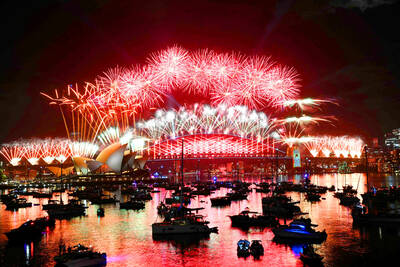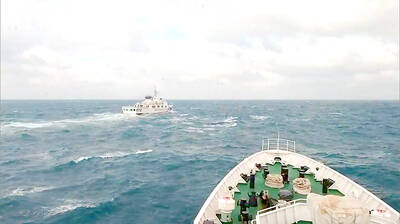A plan to use suicide pilots against US targets was uncovered as early as six years ago during the investigation that led to the arrest of the alleged mastermind of the 1993 World Trade Center bombing, a Philippine police official said yesterday.
Chief Superintendent Avelino Razon also said it was "too much coincidence" that Tuesday's attacks using commercial jets as flying bombs was close to the anniversary of the Sept. 5, 1996, conviction of Ramzi Yousef, Abdul Hakim Murad and Wali Khan Amin Shah for a plot to bomb US airliners in 1995.
Murad was arrested in Manila in January 1995 after fire broke out in an apartment he shared with fellow Pakistani Yousef, the alleged mastermind of the 1993 bombing that killed six people and injured 1,000 others. Shah says he is Saudi Arabian with links to Afghanistan.
Razon, then commander for special operations of the Presidential Security Group providing security for the visit of Pope John Paul II that began days after Murad's arrest, said he was captured after he returned to his apartment to dispose of bomb-making materials. Yousef was captured in Pakistan.
"When we interrogated Murad, he mentioned that he was a skilled pilot, trained in the US, in Afghanistan and also here in the Philippines, who was recruited to undertake a suicide mission," Razon said.
"He was committed to ... fly a plane and ram it into some targets," Razon said, adding that information from a laptop computer seized from Murad indicated one target was CIA headquarters. "There was mention of about a dozen" trained pilots to be recruited for such attacks.
"I didn't imagine that they would ram a 757 aircraft into the World Trade Center. I thought the suicide mission [would involve] a Cessna light aircraft loaded with several kilos of explosives, like a Japanese Kamikaze World War II pilot diving into a target," he said.
He said the investigation started with reports on threats to the pope that led to Murad and the discovery of an international terrorist cell in the Philippines that also "had plans to bomb US aircraft and the US CIA headquarters in Langley, Virginia.''
Yousef and his group allegedly planned to bomb 11 US commercial aircraft under "Project Bojinka." But Murad's arrest foiled the plan, Razon said.
Prosecutors in the US trial of Yousef, Murad and Shah said the bombings would have killed 4,000 people in planes flying to Los Angeles, San Francisco, Honolulu and New York, and were aimed at forcing the US to pull out of the Middle East and stop supporting Israel.
The three men were convicted of all charges. Yousef also was found guilty of killing a man with a bomb on a Philippines Airlines jet in 1994 that prosecutors said was a test run for the plot.
Prosecutors said the plot was hatched in the Philippines, where Yousef had turned his Manila apartment into a bomb factory.
"I believe there are still remnants [of the terrorist cell] and we should be vigilant," Razon said.
"My concern is we should as a nation draw lessons from this ... we cannot say that this can only happen to the US ... "
In other developments, a for-mer pilot with Afghanistan's national carrier was quoted as saying yesterday that he had helped train 14 Islamic militants to fly civilian aircraft.
The London-based Asharq al-Awsat newspaper quoted the pilot as saying from an undisclosed location in Afghanistan that the trainees had left the country nearly one year ago to undisclosed locations after completing their training.
The paper did not say if the trainees were among the hijackers who slammed commercial aircraft into the Pentagon in Washington and the World Trade Center in New York on Tuesday.
It said the young trainees were Pakistanis, Afghans and Arab nationals. Some carried European passports and spoke fluent English.

Auckland rang in 2026 with a downtown fireworks display launched from New Zealand’s tallest structure, Sky Tower, making it the first major city to greet the new year at a celebration dampened by rain, while crowds in Taipei braved the elements to watch Taipei 101’s display. South Pacific countries are the first to bid farewell to 2025. Clocks struck midnight in Auckland, with a population of 1.7 million, 18 hours before the famous ball was to drop in New York’s Times Square. The five-minute display involved 3,500 fireworks launched from the 240m Sky Tower. Smaller community events were canceled across New Zealand’s

The Ministry of Foreign Affairs (MOFA) yesterday said it is closely monitoring developments in Venezuela, and would continue to cooperate with democratic allies and work together for regional and global security, stability, and prosperity. The remarks came after the US on Saturday launched a series of airstrikes in Venezuela and kidnapped Venezuelan President Nicolas Maduro, who was later flown to New York along with his wife. The pair face US charges related to drug trafficking and alleged cooperation with gangs designated as terrorist organizations. Maduro has denied the allegations. The ministry said that it is closely monitoring the political and economic situation

‘SLICING METHOD’: In the event of a blockade, the China Coast Guard would intercept Taiwanese ships while its navy would seek to deter foreign intervention China’s military drills around Taiwan this week signaled potential strategies to cut the nation off from energy supplies and foreign military assistance, a US think tank report said. The Chinese People’s Liberation Army (PLA) conducted what it called “Justice Mission 2025” exercises from Monday to Tuesday in five maritime zones and airspace around Taiwan, calling them a warning to “Taiwanese independence” forces. In a report released on Wednesday, the Institute for the Study of War said the exercises effectively simulated blocking shipping routes to major port cities, including Kaohsiung, Keelung and Hualien. Taiwan would be highly vulnerable under such a blockade, because it

UNRELENTING: China attempted cyberattacks on Taiwan’s critical infrastructure 2.63 million times per day last year, up from 1.23 million in 2023, the NSB said China’s cyberarmy has long engaged in cyberattacks against Taiwan’s critical infrastructure, employing diverse and evolving tactics, the National Security Bureau (NSB) said yesterday, adding that cyberattacks on critical energy infrastructure last year increased 10-fold compared with the previous year. The NSB yesterday released a report titled Analysis on China’s Cyber Threats to Taiwan’s Critical Infrastructure in 2025, outlining the number of cyberattacks, major tactics and hacker groups. Taiwan’s national intelligence community identified a large number of cybersecurity incidents last year, the bureau said in a statement. China’s cyberarmy last year launched an average of 2.63 million intrusion attempts per day targeting Taiwan’s critical